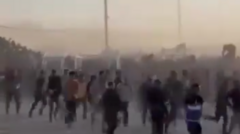In the wake of a devastating earthquake that shook central Myanmar, the death toll has surged to almost 700, with fears that the number could rise significantly. The 7.7-magnitude quake struck near Mandalay, causing widespread destruction and prompting an appeal from the military government for international aid. Rescue operations face numerous challenges, including logistical hurdles and the military's tight control over information.
Myanmar Earthquake Devastation: Death Toll Rises Amid Ongoing Rescue Efforts

Myanmar Earthquake Devastation: Death Toll Rises Amid Ongoing Rescue Efforts
A powerful 7.7-magnitude earthquake near Mandalay has left nearly 700 dead and over 1,600 injured, with rescue operations hampered by Myanmar's military restrictions and ongoing instability.
March 29, 2025 — The repercussions of a significant earthquake in Myanmar are intensifying, as the death toll now stands at nearly 700, with over 1,600 individuals reported injured by the country's military government. The 7.7-magnitude quake struck on the afternoon of March 28, near Mandalay, and was felt across parts of Southeast Asia, including locations as far away as Thailand and southern China.
Areas affected by the earthquake, particularly near the Sagaing Fault, have reported extensive damage, with entire buildings collapsing in Mandalay and surrounding regions. The capital, Naypyidaw, and major urban centers like Ruili in China also witnessed structural failures due to the seismic activity.
Internationally, the response has begun, although it remains uncertain how quickly aid can reach the victims. The military regime, which has faced extensive sanctions from Western countries following its 2021 coup, has issued a rare call for assistance. The situation is complicated by the country’s long-standing restrictions on humanitarian access, exacerbated by the junta’s tight grip on the internet and information flow.
Rescue efforts are urgently underway, particularly in areas densely populated like Mandalay where buildings are vulnerable to earthquakes. Past estimates from the U.S. Geological Survey suggest that the casualty count could potentially exceed 10,000. As rescue workers strive to locate survivors, they have identified signs of life beneath the ruins, including 15 construction workers trapped in a collapsed building.
The humanitarian implications of this disaster are dire. Myanmar’s complex political landscape and the history of military oppression raise questions about how effectively international aid can be distributed to the most affected regions. Challenges include ensuring the safety of aid workers and the potential manipulation of aid by the military to favor certain areas over others.
As rescue and recovery operations proceed, a full assessment of the destruction may take weeks or even months, leaving many families in distressing uncertainty about their loved ones buried beneath the rubble. This profound tragedy highlights not just the immediate needs for disaster response but also the long-term implications of Myanmar’s isolation from the global community.
Areas affected by the earthquake, particularly near the Sagaing Fault, have reported extensive damage, with entire buildings collapsing in Mandalay and surrounding regions. The capital, Naypyidaw, and major urban centers like Ruili in China also witnessed structural failures due to the seismic activity.
Internationally, the response has begun, although it remains uncertain how quickly aid can reach the victims. The military regime, which has faced extensive sanctions from Western countries following its 2021 coup, has issued a rare call for assistance. The situation is complicated by the country’s long-standing restrictions on humanitarian access, exacerbated by the junta’s tight grip on the internet and information flow.
Rescue efforts are urgently underway, particularly in areas densely populated like Mandalay where buildings are vulnerable to earthquakes. Past estimates from the U.S. Geological Survey suggest that the casualty count could potentially exceed 10,000. As rescue workers strive to locate survivors, they have identified signs of life beneath the ruins, including 15 construction workers trapped in a collapsed building.
The humanitarian implications of this disaster are dire. Myanmar’s complex political landscape and the history of military oppression raise questions about how effectively international aid can be distributed to the most affected regions. Challenges include ensuring the safety of aid workers and the potential manipulation of aid by the military to favor certain areas over others.
As rescue and recovery operations proceed, a full assessment of the destruction may take weeks or even months, leaving many families in distressing uncertainty about their loved ones buried beneath the rubble. This profound tragedy highlights not just the immediate needs for disaster response but also the long-term implications of Myanmar’s isolation from the global community.






















